
Moclips is an unincorporated community and census-designated place (CDP) in Grays Harbor County, Washington, United States. The population was 207 at the 2010 census. It is located near the mouth of the Moclips River.

The Salishan languages are a family of languages of the Pacific Northwest in North America. They are characterised by agglutinativity and syllabic consonants. For instance the Nuxalk word clhp’xwlhtlhplhhskwts’, meaning "he had had [in his possession] a bunchberry plant", has twelve obstruent consonants in a row with no phonetic or phonemic vowels.

The Yakama are a Native American tribe with nearly 10,851 members, based primarily in eastern Washington state.

The Chehalis people or Tsihalis are a native people of western Washington state in the United States. They should not be confused with the similarly named Chehalis First Nation of the Sts'Ailes people along the Harrison River in the Fraser Valley area of British Columbia.
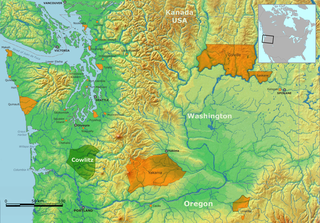
The term Cowlitz people covers two culturally and linguistically distinct indigenous peoples of the Pacific Northwest; the Lower Cowlitz or Cowlitz proper, and the Upper Cowlitz / Cowlitz Klickitat or Taitnapam. Lower Cowlitz refers to a southwestern Coast Salish people, which today are enrolled in the federally recognized tribes: Cowlitz Indian Tribe, Quinault Indian Nation, and Confederated Tribes of the Chehalis Reservation. The Upper Cowlitz or Taitnapam, is a Northwest Sahaptin speaking people, part of the Confederated Tribes and Bands of the Yakama Nation.

Chinookan peoples include several groups of Indigenous people of the Pacific Northwest in the United States who speak the Chinookan languages. Since at least 4000 BCE Chinookan peoples have resided along the Lower and Middle Columbia River (Wimahl) from the river's gorge downstream (west) to the river's mouth, and along adjacent portions of the coasts, from Tillamook Head of present-day Oregon in the south, north to Willapa Bay in southwest Washington. In 1805 the Lewis and Clark Expedition encountered the Chinook Tribe on the lower Columbia.

Shoalwater Bay Tribe is a Native American tribe in western Washington state in the United States. They are descendants of the Willapa Chinook, Lower Chehalis, and the Northern Athabaskan speaking Willapa (Kwalhioqua). The Shoalwater Bay tribe lives on the southwest coast of Washington in northwestern Pacific County, along the shores of Willapa Bay where the 2.693 km² Shoalwater Bay Indian Reservation with 70 inhabitants is located. The reservation is just west of Tokeland, Washington.
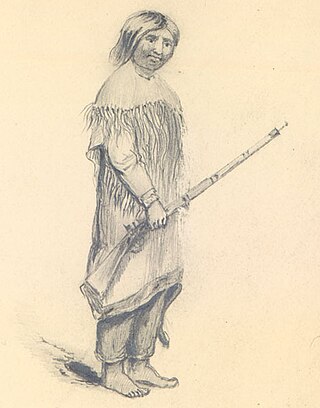
The Umpqua people are an umbrella group of several distinct tribal entities of Native Americans of the Umpqua Basin in present-day south central Oregon in the United States. The area south of Roseburg is now known as the Umpqua Valley.

Athabaskan is a large family of indigenous languages of North America, located in western North America in three areal language groups: Northern, Pacific Coast and Southern. Kari and Potter (2010:10) place the total territory of the 53 Athabaskan languages at 4,022,000 square kilometres (1,553,000 sq mi).
The Tututni tribe is a historic Native American tribe, one of Lower Rogue River Athabascan tribes from southwestern Oregon who signed the 1855 Coast Treaty, and were removed to the Siletz Indian Reservation in Oregon. They traditionally lived along the Rogue River and its tributaries, near the Pacific Coast between the Coquille River on the north and Chetco River in the south. Lower Rogue River Athabascan tribes are a group of Athabascan tribes who were historically located in southwestern Oregon in the United States and speak the same Athabascan language, known as Lower Rogue River.

The Willapa River is a river on the Pacific coast of southwestern Washington in the United States, approximately 20 miles (32 km) long. It drains an area of low hills and a coastal plain into Willapa Bay, a large estuary north of the mouth of the Columbia River.

The Chinookan languages were a small family of languages spoken in Oregon and Washington along the Columbia River by Chinook peoples. Although the last known native speaker of any Chinookan language died in 2012, the 2009-2013 American Community Survey found 270 self-identified speakers of Upper Chinook.
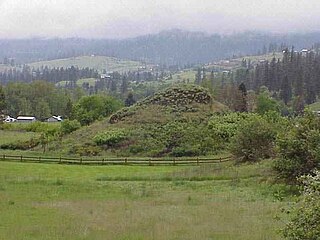
Indigenous peoples of the Northwest Plateau, also referred to by the phrase Indigenous peoples of the Plateau, and historically called the Plateau Indians are Indigenous peoples of the Interior of British Columbia, Canada, and the non-coastal regions of the Northwestern United States.

The Confederated Tribes of the Chehalis Reservation is a federally recognized tribe located in Southwest Washington. The Confederation consists of the Upper and Lower Chehalis, Klallam, Muckleshoot, Nisqually, and Quinault peoples. They are a part of the Northern Straits branch Central Coast Salish peoples of indigenous peoples of the Northwest Coast.
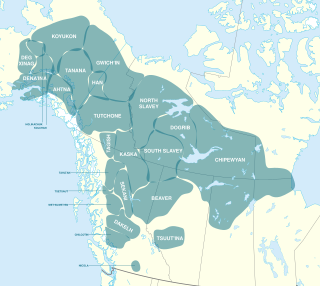
Northern Athabaskan is a geographic sub-grouping of the Athabaskan language family spoken by indigenous peoples in the northern part of North America, particularly in Alaska, Yukon, and the Northwest Territories. The Northern Athabaskan languages consist of 31 languages that can be divided into seven geographic subgroups.
Cowlitz, also known as Cowlitz Salish, is a Tsamosan language of the Coast Salish family of Salishan languages. It was spoken by the Lower Cowlitz people of the Cowlitz Indian Tribe and is spoken today by both Lower and Upper Cowlitz people. Although it went dormant in the 1960s, it is being revitalized by the Cowlitz Tribe.
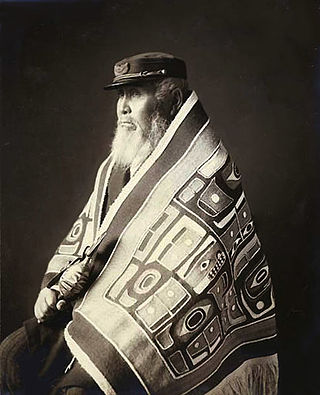
The Indigenous peoples of the Pacific Northwest Coast are composed of many nations and tribal affiliations, each with distinctive cultural and political identities. They share certain beliefs, traditions and practices, such as the centrality of salmon as a resource and spiritual symbol, and many cultivation and subsistence practices. The term Northwest Coast or North West Coast is used in anthropology to refer to the groups of Indigenous people residing along the coast of what is now called British Columbia, Washington State, parts of Alaska, Oregon, and Northern California. The term Pacific Northwest is largely used in the American context.

The Satsop River is a stream in the U.S. state of Washington. It has three main tributary forks, the East Fork, West Fork, and Middle Fork Satsop Rivers. The main stem Satsop River is formed by the confluence of the West and East Forks. The Middle Fork is a tributary of the East Fork. The three forks are much longer than the main stem Satsop itself, which flows south from the confluence only a few miles to join the Chehalis River near Satsop, Washington. Other significant tributaries include the Canyon River and Little River, both tributaries of the West Fork Satsop, and Decker Creek, a tributary of the East Fork Satsop River. The Satsop River's major tributaries originate in the Olympic Mountains and its southern foothills, the Satsop Hills, within Grays Harbor and Mason counties. Most of the Satsop River's watershed consists of heavily wooded hill lands. The upper tributaries extend into Olympic National Forest, approaching but not quite reaching Olympic National Park.
Lower Chinook is a Chinookan language spoken at the mouth of the Columbia River on the west coast of North America.
Kwalhioqua–Clatskanie (Kwalhioqua–Tlatskanai) is an extinct Athabaskan language of northwest Oregon and southwest Washington state, along the lower Columbia River.















